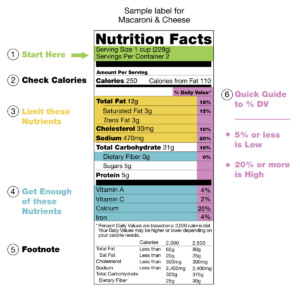By Ashton Johnson, A.C.E. Certified Personal Trainer, B.S. Public Health | Personal Trainer Near Edina MN
Looking at a nutrition label is a great way to help track your meals, and make the best choice at the grocery store. It’s easy to get lost in the numbers and percentages, but with this step-by-step guide, you’ll be able to navigate the nutrition label like a pro!
First you have to understand why nutrition labels are so important, and what they are used for. Nutrition labels are legally required diagrams that are designed to help you better understand the contents of your food. When tracking your meals, it is important to know what kind of nutrients your food contains, as well as how much of that nutrient it contains. Let’s start from the top!
 In the green highlighted section, we see the serving size, and the number of servings per container. This example shows us that the serving size is 1 Cup. This doesn’t mean that you have to eat 1 Cup of Macaroni, it just means that someone purchasing this product would typically consume 1 Cup each serving. If you choose to eat ½ of a serving, the numbers seen on the label should be divided by 2 to get accurate results. If you choose to eat 2 Cups, the numbers shown on the label would have to be doubled for accurate results.
In the green highlighted section, we see the serving size, and the number of servings per container. This example shows us that the serving size is 1 Cup. This doesn’t mean that you have to eat 1 Cup of Macaroni, it just means that someone purchasing this product would typically consume 1 Cup each serving. If you choose to eat ½ of a serving, the numbers seen on the label should be divided by 2 to get accurate results. If you choose to eat 2 Cups, the numbers shown on the label would have to be doubled for accurate results.
Next we check the calories per serving. For this particular product, it looks like 1 serving is equal to 250 calories. This is important to keep in mind if you are planning on eating more, or less than the labeled serving. Eating ½ of a serving would be around 125 calories, while eating the whole box would be closer to 500 calories, so plan according to your goals!
In the highlighted orange section, we see fats, cholesterol, and sodium. It is common that people tracking their diets will want to limit their intake of these nutrients. How do you know how much is too much? Looking at the purple highlighted section you will find the recommended percent daily value. This percentage tells you how much of this nutrient is recommended per day. If we look at the values labeled for Sodium, we see that the 470 mg, per 1 cup serving of macaroni and cheese, equals about 20% of the recommended daily value. If your goal is to limit sodium intake, this might be something you would only consume ½ a serving of.
Moving down to the blue highlighted section, we see our micronutrients. These are important to know if you are looking to consume more of these nutrients. Looking at this section we see that this product is a good option if we are looking for calcium, and not such a great option if we are looking for Vitamin C.
Keeping your goals and restrictions in mind while tracking your meals can be a challenge, but with help from the nutrition label, you will be able to ensure that you are staying on track, and maintaining a healthy, well balanced diet.
If you’re looking for a great personal trainer in Edina MN, then don’t hesitate to contact your local personal trainers at 3CLICK Fitness today!
